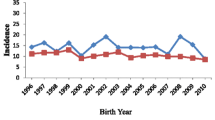Abstract
Intrauterine growth retardation (IUGR) is an important determinant of neonatal mortality, morbidity and poor neurologic outcome. The study was aimed to evaluate the magnitude of perinatal risk factors in causation and the neonatal outcome of small for gestational age (SGA) babies. One hundred and three SGA babies born over a period of one year were retrospectively analysed during their hospital stay. 3.53 per cent of the babies were SGA with mean birth weight of 1657±SD 354 gm (range 600–2200 gm). 68.9 per cent were term babies and 51.5 per cent were females. Toxemia of pregnancy (30.09%), hypertensive diseases of pregnancy (HDP) excluding toxemia (5.8%), diabetes mellitus (1.94%), medical disorders including renal and cardiac (3.88%), anemia (Hb<8 gm%) and IU infection (0.97%) were the main conditions responsible for SGA. In 56.3% pregnancies, no cause could be ascertained. The common perinatal problems were infections in 27 (26.2%), birth asphyxia in 22 (21.36%), polycythemia in 25 (24.3%), jaundice in 22 (21.36%) and hypoglycemia in 7 (6.8%). Congenital malformations in 2 (1.94%) and Hyaline membrane disease in 1 (0.97%) were uncommon problems. 5.8 per cent babies died due to various perinatal problems. Based on these findings it was concluded that idiopathic (? Constitutional) intrauterine growth retardation was the commonest cause of SGA in Indian babies. 58.3 per cent babies had neonatal problems and they had a better survival compared to their western counterparts.
Similar content being viewed by others
References
Robinson RJ. Assessment of gestational age by neurological examination.Arch Dis. Child 1966; 41: 437–447.
Farr V, Mitchell RG, Neligan GA and Parkin JM. Definition of some external characteristics used in the assessment of gestational age.Develop Med. Child Neurol 1996; 8: 507–508.
Farr V, Kerridge DF, Mitchell RG. The value of some external characteristics in the assessment of gestational age at birth.Develop Med Child Neurol 1966; 8: 657–660.
Arias F. Fetal growth retardation. In: Practical Guide to High Risk Pregnancy and Delivery. 2nd ed., Mosby-Year book 1993; 301–318.
Thomson JM, Wright, SP, Mitchell EAet al. Risk Factors for small for gestational age infants: a New Zealand Study. New Zealand Cot Death Study group.NZ Med. J 1994; 107: 71–73.
ZM Van der Spuy, Steer PJ, McCusker Met al. Outcome of pregnancy in underweight women after spontaneous and induced ovulation.Br. Med J 1988; 296: 962–965.
Dumont M, Mazuez M. Etiologic factors of fetal hypotrophy, Apropos of 600 cases.J Gynaecol Obstet Biol Reprod. 1985; 14: 439–448.
Tenovud AH, Kero PO, Korvenranta HJet al. Risk factors associated with severely small for gestational age neonates.Am J Perinatal 1988; 5: 267–271.
Sibai BM, Anderson GD. Pregnancy outcome of intensive therapy in severe hypertension in first trimester.Obstet Gynaecol 1986; 67: 517–522.
Sood M, Kumar S, Kashyap N, Berry Met al. Etiological factors and perinatal risk factors in symmetrical and asymmetrical intrauterine growth retardation.Indian J Pediatr 1987; 54: 926–929.
Ruys-Dudok Van Heel I, de Leeuw R. Clinical outcome of small for gestational age preterm infants.J Perinat Med 1989; 17: 77–83.
Arora NK, Paul VK, Singh M. Morbidity and mortality in term infants with intrauterine growth retardation.J. Trop Pediatrics 1987; 33: 186–189.
Lewis DB, Wilson CB. Developmental Immunology and role of Host defenses in neonatal susceptibility to infection. In: Remington JS, Klein JO, (eds.),Infectious Diseases of the Fetus and Newborn Infant. 4th ed. WB Saunders Company, 1995; 20–98.
Kishan J, Elzouki AY, Mir NA, Faquih AM. Ponderal index as a predictor of neonatal morbidity in small for gestational age infants.Indian J Pediatr 1985; 52: 133–137.
Walther, FJ, Ramaekers LHJ. Neonatal morbidity of SGA infants in relation to their nutritional status at birth.Acta Pediatr Scand. 1982, 71: 437–440.
Meberg, A. Hemoglobin concentrations and erythropoietin levels in appropriate and small for gestational age infants.Scand J Haematol 1980; 24: 162–168.
Lubchenco LO, Bard H. Incidence of hypoglycemia in newborn infants classified by birth weight and gestational age.Pediatrics 1971, 47: 831–838.
Rabor IF, Oh W, Wu Pet al. Effects of early and late feeding of intrauterine fetally malnourished infants.Pediatrics 1968; 42: 261–269.
Author information
Authors and Affiliations
Rights and permissions
About this article
Cite this article
Narang, A., Chaudhuri, M.K. & Kumar, P. Small for gestational age babies: Indian scene. Indian J Pediatr 64, 221–224 (1997). https://doi.org/10.1007/BF02752452
Issue Date:
DOI: https://doi.org/10.1007/BF02752452



